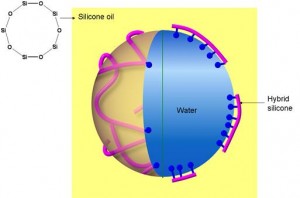Siloxane based materials have become very important in industrial processes because of their unique properties in both aqueous and non-aqueous systems. Among them, a special class of hydrophilically modified molecules is termed silicone surfactants. These surfactants are commonly used as mold release agents, PU foam stabilizers, superspreaders for aqueous systems and emulsifiers in cosmetics.
We are investigating the interfacial characteristics of functionally grafted dimethylsiloxane backbone chains modified with various cationic, anionic, non-ionic and amphoteric functional groups.
To study the effect of functional groups on modified silicones the liquid-liquid interfacial properties, phase diagrams and rheology behaviors were monitored. Various modified polymers show markedly different emulsion stabilizing characteristics based on the hydrophilicity of functional moieties. Also viscosities of emulsions were observed to increase drastically due to interactions of functional groups in aqueous phase, and thus formation of loose networks among the siloxane backbones. The diagrams have been established to design formulations that would possess properties desired for a given application.

